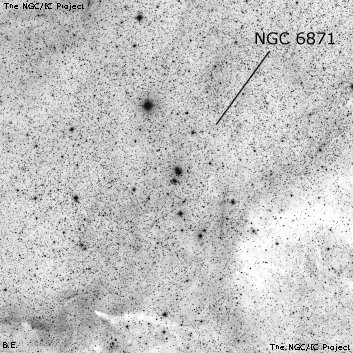NGC/IC Project Restoration Effort
(This is a very very beta version)
NGC6871


Basic Information
Location and Magnitude
Right Ascension: 20:6:27.0
Declination: +35:47:24
Constellation: CYG
Visual Magnitude: 5.2
Historic Information
Discoverer: Struve W.
Year of discovery: 1825
Discovery aperture: 9.6
Observational
Summary description: Cl, st L and S, ** inv
Sub-type: IV3p
Corwin's Notes
=====
NGC 6871 is not much of a cluster, being defined primarily by the 4-6 bright
stars in the area. Aside from the curving line of 6-8 stars just to the
south, there just isn't much here to suggest a cluster. I haven't checked the
professional literature to see if these dozen or stars actually do form a
cluster, but -- with the bright stars to the north -- this might well be a
pretty sight in a telescope.
Steve's Notes
=====
NGC 6871
18" (9/26/11): bright, large, rich cluster but not isolated in the field, so the catalogued diameter of 20' seems somewhat arbitrary. At 175x, roughly 200 stars are visible within the region, though there are really too many to count. The dominant feature are two bright multiple stars near the center: SHJ 314 = 6.8/7.3 at 35" with 4 faint companions and SHJ 315 = 7.9/8.8 at 20" with 8 companions including a trio of mag 11 stars close west, a 15" pair of mag 10.5 stars close east and a tight string of 3 or 4 fainter stars close southeast. NGC 6871 forms a close pair of clusters with Biurakan 1 (centered on a mag 7.3 star), just off the southeast side. The little-known Wolf-Rayet shell surrounding W-R 134/135 lies 45' NE.
13.1" (8/25/84): dominated by two bright multiple stars: SHJ 314 = 6.8/7.3 at 35" with four additional close companions and SHJ 315 = 7.9/8.8 pair at 20" surrounded by several mag 11 stars. The bright pairs are oriented N-S and separated by about 2'. The cluster itself is in a bright, rich field with no apparent boundaries.
8" (6/81): two sets of multiple stars in a very rich field including §440 = mag 7, 12, 11, 9.5, 11.5, 8 at 7", 11", 11", 28" and 36". Located 13' SW of a mag 5.5 27 Cygni.



